Ancient Etruscan Temple Stone Discovered
Newswise reports archeologists working on a temple wall at Poggio Colla, where many ancient Etruscan objects have been found, discovered an inscription to Uni. An important female goddess who represented fertility, Uni may have been the main deity worshipped at the sanctuary.
The sacred text may be the longest Etruscan inscription discovered on stone, said archaeologist Gregory Warden, professor emeritus at Southern Methodist University. It's also rare to identify the deity worshipped at an Etruscan sanctuary.
"It is also possible that it expresses the laws of the sanctuary -- a series of prescriptions related to ceremonies that would have taken place there, perhaps in connection with an altar or some other sacred space," said Warden.
The slab was embedded in the foundations of a temple where it had been buried for more than 2,500 years. Warden said while archaeologists understand how Etruscan grammar works, they expect to discover new words from the 120 characters in the inscription. The results are being published in the Etruscan Studies journal.
"The location of its discovery -- a place where prestigious offerings were made -- and the possible presence in the inscription of the name of Uni, as well as the care of the drafting of the text, which brings to mind the work of a stone carver who faithfully followed a model transmitted by a careful and educated scribe, suggest that the document had a dedicatory character," said Adriano Maggiani, a scholar working to decipher the inscription.
The large sandstone slab dates to the 6th century BCE, and was discovered in the Mugello Valley in north central Italy. Permanent Etruscan inscriptions are rare since they commonly used linen cloth books or wax tablets.
"We can at this point affirm that this discovery is one of the most important Etruscan discoveries of the last few decades," Warden said. "It's a discovery that will provide not only valuable information about the nature of sacred practices at Poggio Colla, but also fundamental data for understanding the concepts and rituals of the Etruscans, as well as their writing and perhaps their language.”

